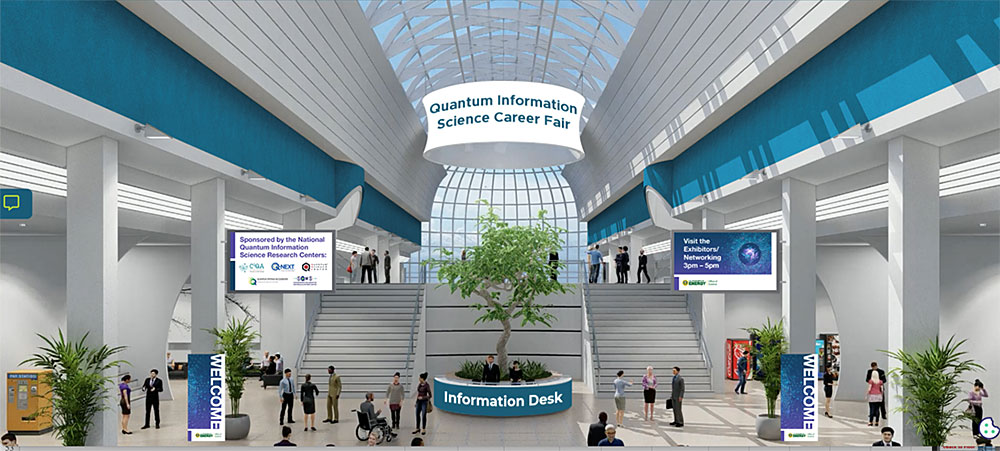As the field of Quantum Information Science (QIS) grows, so too does the need for professionals to support and expand on the research, application, and commercialization of this exciting new area of technology. To bring key players in the field together with new talent from across the country, the U.S. Department of Energy (DOE) Office of Science’s National Quantum Information Science (QIS) Research Centers (NQISRCs) sponsored a second virtual QIS career fair on Sept. 14, 2022, led by Brookhaven National Laboratory’s Co-design Center for Quantum Advantage (C2QA).
“The degree of participation this year demonstrated that there are many students, job seekers, and career-changers who are interested in employment opportunities within QIS but may not have known how to access them,” said Kimberly McGuire, career fair co-organizer and chief operating officer for C2QA. “Hosting this event virtually allowed it to be the largest and most accessible QIS career fair in the United States. It gave participants the ability to connect directly with hiring managers from national labs, academia, and industry, regardless of their respective locations. The large number of registrants speaks volumes; there’s a significant interest in joining the quantum workforce and it’s clear that we need to get the word out if we want to successfully fill the research, technician, and support roles that will advance this field even further.”
The event drew in nearly 1,000 registrants, 100 more than the previous year, and about half of those who registered attended—about 150 more than the previous year. About three-quarters of the attendees were students (27 percent undergrads and 39 percent graduate students) and postdocs (10 percent). To cater to the diverse makeup of attendees, several panels and breakout sessions were tailored to students and professionals of all levels and backgrounds, including sessions for candidates seeking technician and non-STEM roles in QIS.
“DOE has invested millions of dollars in quantum information science, giving the NQISRCs a unique opportunity to contribute to solutions for some of the biggest quantum challenges,” said Andrew Houck, C2QA director. “For us to rise to these challenges, it will take innovative contributions from a diverse candidate pool. Their talent, experience, and ideas are key to building the QIS workforce of both today and the future.”
“There was diverse representation from speakers, panelists, and attendees from across the QIS ecosystem on our agenda,” said McGuire. “We had participation from the DOE Office of Science, the White House, and the Quantum Economic Development Consortium (QED-C) as well as from the national labs, academia, and industry. It gave attendees a good sense of the QIS landscape and help them seek internships and jobs that best match their career goals.”
Panels and discussions were researched and thoughtfully curated based on feedback from students, professionals, and experts in preparation for the event. There was something for everyone on the agenda, from introductory talks aimed at undergrads exploring the field, to more focused presentations appealing to those that are more experienced in the field.
“We came up with some really unique programming that engaged students directly in topics they were most interested in,” remarked Jake Douglass, operations deputy director for Quantum Systems Accelerator (QSA) and member of the QIS career fair planning team. “By working with students across the five NQISRCs to identify meaningful programming, utilizing pre-event surveys, and jointly supporting planning and outreach efforts, we were able to reach a broad audience and prepare material and programming that directly met student needs.”
Virtual exhibitor booths got quite a bit of action, racking in 4,537 visits in total through the duration of the event. Industry leaders, including Amazon, IBM, and Rigetti Computing, presented alongside national laboratories, like Brookhaven National Laboratory and Pacific Northwest National Laboratory, and academic institutions, like Harvard, Purdue, and University of Illinois. These are just a few of the 27 booths comprising the virtual exhibitor floor. Using the vFairs online platform, participating institutions reached a large, broad candidate pool, bringing in more than 100 job applications directly through the platform during the career fair. Candidates directly engaged with hiring managers through the exhibit booths and virtual networking lounges and were informed about current openings and opportunities.
The QIS Career Fair underscored DOE’s mission to strengthen recruitment, retention, and promotion while removing inequitable barriers to workforce opportunities by providing a pathway for those in underrepresented communities to attend. A significant number of students and postdocs represented Minority Serving Institutions (MSIs) and Historically Black Colleges and Universities (HBCUs), including North Carolina A&T State University, University of Illinois Chicago, Coppin State University, and CUNY Bronx Community College. During the planning process, an important goal of the NQISRCs was to ensure direct access to hiring managers for these communities.
This event could not have been possible without the cooperation of the five NQISRCs, the time and effort volunteered by all panelists and moderators, and the coordination of Diana Murphy, C2QA’s former head of Outreach, Education, & Workforce Development (OEWD), and Kimberly McGuire.
With plans already underway for the fall 2023 QIS career fair, the goal for that next gathering will be to expand the visibility and access to students in community and four-year colleges and universities, technicians, non-STEM support roles, and professionals interested in making a career change and applying their skills to the quantum workforce. By showcasing the passion, progress, and potential that drives experts in QIS to achieve amazing things, these career fairs aim to inspire and aid the quantum workforce of the future.
Brookhaven National Laboratory is supported by the Office of Science of the U.S. Department of Energy. The Office of Science is the single largest supporter of basic research in the physical sciences in the United States and is working to address some of the most pressing challenges of our time. For more information, visit science.energy.gov.
Follow @BrookhavenLab on Twitter or find us on Facebook.
